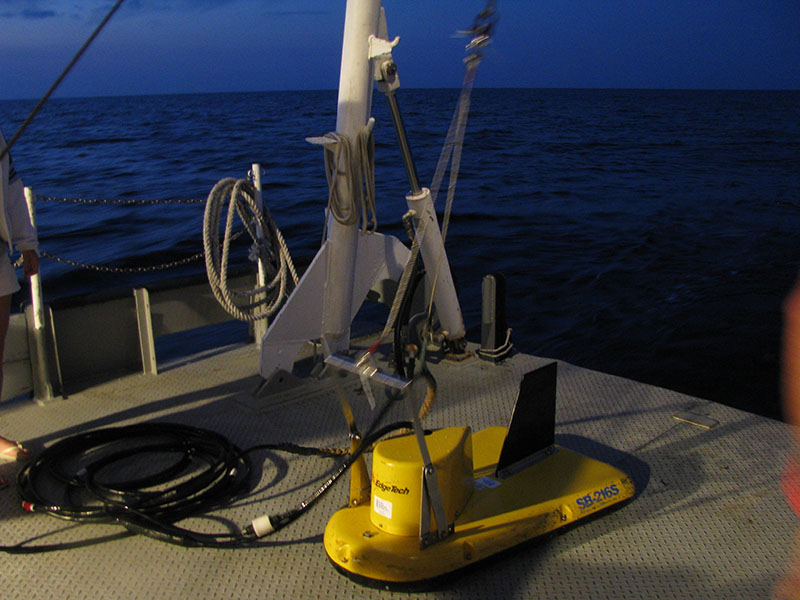
By Amanda Evans, Coastal Environments, Inc.
When the opportunity to submit a proposal to explore paleolandscapes in the Gulf of Mexico was presented by NOAA, I got really excited. I had been thinking about this project for almost 10 years. I was fortunate enough to be part of a previous project mapping and exploring the northwestern Gulf of Mexico for evidence of submerged prehistoric archaeology, funded by the Bureau of Ocean Energy Management’s Coastal Marine Institute (BOEM CMI). I wrote my dissertation based on that work, and a publicly available technical report followed. While the work ended, the questions didn’t. We found beautifully preserved channels in places we didn’t expect them to be. We found pollen from plant species that would be cultivated by humans several thousand years later. We identified resource-rich habitats but could never put people in that picture. It made me wonder, did we really know what this landscape was like?
Archaeologists, geologists, and oceanographers have been questioning the ability to find prehistoric archaeological sites offshore since the 1970s. The first question was “would anything be intact enough to find?” The short answer is yes. The second question was “how do we look for it?” That question gets a little harder to answer. The short answer is, “it depends.” It depends on where in the world you want to look. What is the geology like? Is the seafloor karst, or coral encrusted, or part of an alluvial plain? How has sea level changed at that location? Despite these questions, archaeologists do agree on some of the basic methods, like using remote sensing to survey large areas and then sampling the physical environment. Some places in the world have amazing submerged sites close to shore, exposed at the seafloor, and accessible by divers. The northwestern Gulf of Mexico is not one of those places.

Richard Weinstein (left), Robert Floyd (middle), and Melanie Stright (right) on of the first exploration surveys for offshore archaeological sites, 1984. Image courtesy of Richard Weinstein. Download larger version (jpg, 703 KB).
For this project, we started with two locations that were previously identified through archaeological mapping and exploration projects. Both were from the same water depth (about 50 feet), and both dated to about the same time period, 8,500 BP or about 10,500 years ago. They were 48 miles apart from one another, but they gave us an area to focus on. And in between the two locations, along the shoreline, were known archaeological sites dating to the same time period. This helped us narrow our search area from 40 million acres of continental shelf down to a more manageable 234 square miles. From there we identified five key areas to begin our search.

Map of preliminary survey areas, northwestern Gulf of Mexico. Image courtesy of Paleolandscapes and the ca. 8,000 BP Shoreline of the Gulf of Mexico Outer Continental Shelf. Download larger version (jpg, 368 KB).

Map of broad valley with previously unknown valley system mapped from previous exploration. Image courtesy of Paleolandscapes and the ca. 8,000 BP Shoreline of the Gulf of Mexico Outer Continental Shelf. Download larger version (jpg, 451 KB).
Focusing offshore of Texas and Louisiana, we started searching through available data. We wanted to see where channels had been mapped before. I should explain that we focus on channels because people have always needed, and will always need, access to clean, fresh water. Other archaeologists have looked at correlations between landscape features associated with freshwater sources, like sinkholes or streams, and the presence of archaeological sites. The geology of the northwestern Gulf of Mexico suggests that if we find the channels, we find the water, and maybe the people. We reviewed existing data and reports submitted to BOEM and the Texas Historical Commission for any mapped features that warranted further exploration. We also looked at existing and ongoing research projects, to make sure we weren’t surveying the same areas as someone else. We have designed our project to build on previous exploration, and to go a step beyond what is known. We want to create a better map for others to follow.

View from offshore. Image courtesy of Paleolandscapes and the ca. 8,000 BP Shoreline of the Gulf of Mexico Outer Continental Shelf. Download larger version (jpg, 3.2 MB).
Coastal Environments, Inc. (CEI)
Evans, A.M.
Masters, P. M. and N.C. Flemming (eds.)
Pearson, C. E., D. B. Kelley, R. A. Weinstein, and S. M. Gagliano